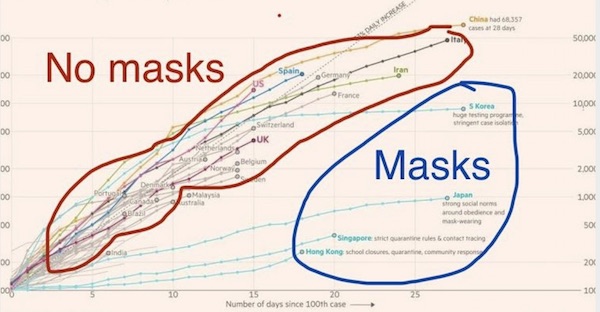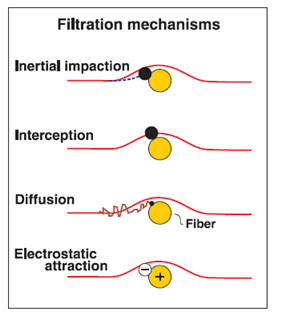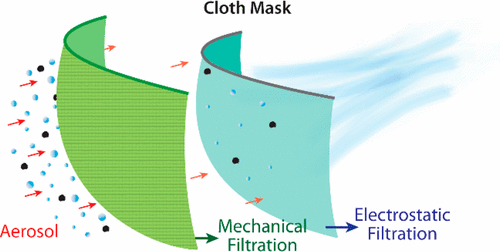Science behind masks -- Why masks work in preventing disease
Masks by Country
In early march all countries were aware the virus was a pandemic although WHO did not mistakingly declare it one till March 11, 2020. Countries such as Korea, Taiwan, Vietnam and Singapore were well aware of the necessity to wear masks. Western countries were hesitant with the US Surgeon General saying on February 29, 2020: "Seriously people — STOP BUYING MASKS!" The surgeon general, Jerome M. Adams, said in a tweet on Saturday morning. "They are NOT effective in preventing general public from catching #Coronavirus, but if health care providers can't get them to care for sick patients, it puts them and our communities at risk!"
In cotrast the Head of CDC in China, George Gao, when asked: "What mistakes are other countries making?
Gao said: "... The big mistake in the U.S. and Europe, in my opinion, is that people aren't wearing masks. This virus is transmitted by droplets and close contact. Droplets play a very important role—you've got to wear a mask, because when you speak, there are always droplets coming out of your mouth. Many people have asymptomatic or presymptomatic infections. If they are wearing face masks, it can prevent droplets that carry the virus from escaping and infecting others..."(ref. 1)


(left or Top) NYC Subway did not require masks in early March 2020 even though social distancing was not possible. South Korea required masks as soon as they knew about Covid-19 in China. The graph below clearly shows that those countries that started wearing masks early benefited the most.
A Comparison of Covid-19 cases from countries wearing masks and not wearing masks. Source: John Hopkins University-CSSE Worldometers Data
-Updated March 20, 2020
Source: John Hopkins University-CSSE Worldometers Data
-Updated March 20, 2020
What is the difference between a mask and a respirator?
Not all face coverings are the same. There is a clear difference between a mask and a respirator.
Surgical or Medical Masks are designed to protect the patient from exhaled microorganisms from the healthcare provider wearing one. Masks are FDA cleared. At this time, the U.S. Food and Drug Administration has not approved any type of surgical mask specifically for protection against the coronavirus, but these masks may provide some protection when N95 masks are not available.
Some masks if properly made with different common fabrics can provide enhanced performance.
From: Aerosol Filtration Efficiency of Common Fabrics Used in Respiratory Cloth Masks --ACS april 2020 (See reference 2)
"...We have carried out these studies for several common fabrics including cotton, silk, chiffon, flannel, various synthetics, and their combinations. Although the filtration efficiencies for various fabrics when a single layer was used ranged from 5 to 80% and 5 to 95% for particle sizes of <300 nm and >300 nm, respectively, the efficiencies improved when multiple layers were used and when using a specific combination of different fabrics. Filtration efficiencies of the hybrids (such as cotton–silk, cotton–chiffon, cotton–flannel) was >80% (for particles <300 nm) and >90% (for particles >300 nm). We speculate that the enhanced performance of the hybrids is likely due to the combined effect of mechanical and electrostatic-based filtration. .." (ref. 2). Aerosol Filtration Efficiency of Common Fabrics Used in Respiratory Cloth Masks --ACS Nano April 2020 -- See also below -- Making your own mask
Respirators are designed to protect the wearer from inhaling hazardous atmospheres, including fumes, vapours, gases and particulate matter such as dusts and airborne microorganisms. The N95 respirator filters have been tested and certified by NIOSH to be at least 95% efficient when tested against very "small" particles that are the most difficult size to filter (approximately 0.3 microns).
How do respirator masks work?
A respirator mask such as: N95, K95, and FFP2, is a respiratory protective device designed to achieve a very close facial fit and very efficient filtration of airborne particles. The 4 main mechanism used filtration are: inertial impactation, interception, diffusion and el;ectrostatic attraction. Fibrous filters constructed from charged fibers, add the additional mechanism of electrostatic attraction.. This mechanism aids in the collection of both larger and smaller particle sizes. This latter mechanism is very important to filtering facepiece respirator filters that meet the stringent NIOSH filter efficiency and breathing resistance requirements because it enhances particle collection without increasing breathing resistance. (ref. 3)

- Inertial impaction: With this mechanism, particles having too much inertia due to size or mass cannot follow the airstream as it is diverted around a filter fiber. This mechanism is responsible for collecting larger particles.
- Interception: As particles pass close to a filter fiber, they may be intercepted by the fiber. Again, this mechanism is responsible for collecting larger particles.
- Diffusion: Small particles are constantly bombarded by air molecules, which causes them to deviate from the airstream and come into contact with a filter fiber. This mechanism is responsible for collecting smaller particles.
- Electrostatic attraction: Oppositely charged particles are attracted to a charged fiber. This collection mechanism does not favor a certain particle size.
The CDC recommends the use of respirators with at least N95 certification to protect the wearer from inhalation of infectious particles including Mycobacterium tuberculosis, avian influenza, severe acute respiratory syndrome (SARS), pandemic influenza, and Ebola.
Size of different viruses
Most viruses are very small and for that reason most cloth coverings and masks will not block them from exposing the wearer.
Rhinoviruses, which cause common cold, belong to the Picornaviridae family, small non-enveloped viruses (diameter 15-30 nm) containing a single-stranded RNA genome. (ref. 4)
Influenza virus particles have a size of 80–120 nm -- (ref. 5).
Measles virus is a paramyxovirus, of the genus Morbillivirus. It is 100-200 nm in diameter, with a core of single-stranded RNA, source-- History of Vaccines.
All CoVs are pleomorphic RNA viruses characteristically containing crown-shape peplomers with 80-160 nM in size and 27-32 kb positive polarity. (ref. 6)
COVID-19 vifrus has a size of 60–140 nm with mean size of 100 nm (i.e. nano-aerosol). (ref. 7)Importance of electrostatic properties of a Respirator in filtering Covid-19
COVID-19 vifrus has a size of 60–140 nm with mean size of 100 nm (i.e. nano-aerosol). Even the N95 mask has a filtering cxapabiliity of 300 nm (.03 microns). Yet it has been shown the mask is 95% efficient against small particles. A significant mechanism of particle capture is due to electrostatic properties of the fibers.
How do electrostatic air filters work? While a standard air filter performs sufficiently to filter larger air particles from the air, they fail to grab some of the smaller particles. Electrostatic air filters use the naturally occurring phenomenon of static electricity to capture air particulates. These filters use combinations of polyurethane and polypropylene layers and filtration media, which generate static electricity by creating friction as air passes through the filter.
The filtration material on the N95 3M mask is an electrostatic non-woven polypropylene fiber.
Electrostatic air filters ideally work like magnets. The combination of positive and negative ions creates a magnetic field that attracts air particulates as they pass through the filtration material. An electrostatic air filter is very efficient at capturing between 80 and 90 percent of dust, pollen, pet dander, bacteria, mold spores and smoke in your indoor air. This is a much higher rate of capture than standard fiberglass or cotton-pleated filters.
The need to filter aerosols
Infected people spread viral particles whenever they talk, breathe, cough, or sneeze in the form, of droplets and aerosols. Aerosols remain suspended in the air for longer durations than droplets due to their small size and are known to play a key role in spreading infection. droplets that are smaller than 1 μm tend to stay in the environment as aerosols for longer durations of up several hours (8). Filtration of aerosols follows four basic mechanisms: inertial impaction, interception, diffusion, and electrostatic attraction.( See table above) For aerosols larger than ∼1 μm to 10 μm, the first two mechanisms play a role, on the large exhaled droplets. As the aerosol size decreases, diffusion by Brownian motion and mechanical interception of particles by the filter fibers is a predominant mechanism in the 100 nm to 1 μm range. For nanometer-sized particles, which can easily slip between the openings in the network of filter fibers, electrostatic attraction predominates the removal of low mass particles which are attracted to and bind to the fibers. Electrostatic filters are generally most efficient at low velocities such as the velocity encountered by breathing through a face mask.(see ref 7 and references therein).
Making your own Cloth Mask...You want a mask that protects yourself as well as others!
Some masks if properly made can provide enhanced performance-- why you need at least two layers.
Many people are making their own mask since facial covering is becoming required in many states. Konda et. al.(April 2020) have studied the efficiency of various common fabrics. We summarize some of his findings below but also recommend reading the original article.
Multiple layers are necessary to provide adequate protection and provide electrostatic properties to adhere small aerosols!
Aerosol Filtration Efficiency of Common Fabrics Used in Respiratory Cloth Masks ACS April 2020
 Image: from Aerosol Filtration Efficiency of Common Fabrics Used in Respiratory Cloth Masks -- Multiple layers increase mask efficiency by providing mechanical and Electrostatic Filtration of aerosols.
Image: from Aerosol Filtration Efficiency of Common Fabrics Used in Respiratory Cloth Masks -- Multiple layers increase mask efficiency by providing mechanical and Electrostatic Filtration of aerosols.
Aerosol Filtration Efficiency of Common Fabrics Used in Respiratory Cloth Masks-- Konda et. al.(April 2020)
".. We have carried out these studies for several common fabrics including cotton, silk, chiffon, flannel, various synthetics, and their combinations. Although the filtration efficiencies for various fabrics when a single layer was used ranged from 5 to 80% and 5 to 95% for particle sizes of <300 nm and >300 nm, respectively, the efficiencies improved when multiple layers were used and when using a specific combination of different fabrics. Filtration efficiencies of the hybrids (such as cotton–silk, cotton–chiffon, cotton–flannel) was >80% (for particles <300 nm) and >90% (for particles >300 nm). We speculate that the enhanced performance of the hybrids is likely due to the combined effect of mechanical and electrostatic-based filtration. Cotton, the most widely used material for cloth masks performs better at higher weave densities (i.e., thread count) and can make a significant difference in filtration efficiencies. Our studies also imply that gaps (as caused by an improper fit of the mask) can result in over a 60% decrease in the filtration efficiency, implying the need for future cloth mask design studies to take into account issues of "fit" and leakage, while allowing the exhaled air to vent efficiently. Overall, we find that combinations of various commonly available fabrics used in cloth masks can potentially provide significant protection against the transmission of aerosol particles..."
Readings and References:
1- Cohen, J. 2020. Not wearing masks to protect against coronavirus is a 'big mistake,' top Chinese scientist says. ScienceMag. March 27.
2- Konda, A. et al. 2020 Aerosol Filtration Efficiency of Common Fabrics Used in Respiratory Cloth Masks. ACS Nano. April 24.
3- Brosseau,L. and, and Berry Ann, R.. 2009 N95 Respirators and Surgical Masks. NIOSH Science Blog. October 14.
4- Dreschers, S., et al. 2009 The Cold Case: Are Rhinoviruses Perfectly Adapted Pathogens? Cell Mol Life Sci . Jan;64(2):181-91.
5-Vajda, J. 2016 Size distribution analysis of influenza virus particles using size exclusion chromatography. Journal of Chromatography A Volume 1465, 23 September.
6- Riza Sahin, A. et al. 2019 2019 Novel Coronavirus (COVID-19) Outbreak: A Review of the Current Literature. Eurasian Journal of Medicine and Oncology. Vol. 4. Issue 2.107 - 115.
7-Wallace Woon Fong Leung and Sun, Q. 2020 Electrostatic charged nanofiber filter for filtering airborne novel coronavirus (COVID-19) and nano-aerosols. April 22.
8-Jayaweera, M et al. 2020 Transmission of COVID-19 virus by droplets and aerosols: A critical review on the unresolved dichotomy. Environ Res. Sep; 188: 109819.
Edinformatics -- Living Systems
- What is the human genome and how big is it?
- What is the difference between sexual and asexual reproduction?
- How are living things classified?
- Where is food digested?
- What is gluten, gluten sensitivity and celiac disease?
- How do drugs work?
- Why do carcinogens cause cancer? A molecular view.
- What are the components of blood?
- What-are-the-parts-of-the-heart?
- How does the heart work?
- What is the path blood takes through the circulatory system?
Edinformatics Articles
- Glutathione shown to boost T-cell energy metabolism -- HealthyMolecules.com
- 3 Win 2016 Nobel Prize in Chemistry for work in molecular machines - Nanocars
- What were the Greatest Inventions of all Time -- What are the 300 Greatest Inventions of all time?
- Great Thinkers --Great Minds- Who were the greatest thinkers of all time? EDinformatics puts its list on the WEB... mathematicians, philosophers, artists, writers, scientists ..
- The Adolescent Brain --Why Teenagers Think and Act Differently It now appears some of that baffling behavior of your teenage child (or student) may be the result of neurobiology not raging hormones
- Being Bilingual and using it staves off Dementia-- people who are fully bilingual and speak both languages every day for most of their lives can delay the onset of dementia by up to four years ...
- New Drugs in the Fight Against Alzheimer's --The past few years have brought some encouraging studies to the forefront in Alzheimer's and Dementia with several drugs for Alzheimer's Disease in the pipeline that show promise -- see Alzheimer's Update 2017
- Last Minute Science Projects-- While few good ones are out there, we do have some creative ideas of our own if you are willing to put the time and effort into them
- Culinary Arts or Culinary Science? --Now it's Molecular Gastronomy With changes in how we cook and eat the fields of culinary arts and culinary science appear to be merging forming new areas know as 'Molecular Gastronomy" and Culinology... read more -- Best Culinary Schools in New York -- 2016 Reviews...-- What are the best Recreational Cooking Schools in the World -- Cooking and Travel.
- NCTM Focal Points and Singapore Math ---Will the current Math Curriculum using the NCTM Focal Points be more in line with International Standards? Many schools are implementing a Singapore Style Math component...
- Exercise Could Slow Aging --It now appears that physically active people have cells that look younger at the molecular level than those that are sedentary..
- What is Helium-3 and why it is so important? -Why is China and Russia heading for the moon to mine Helium-3? Can Helium fusion solve the Earth's energy problems?
- How does Tamiflu Work Against the Flu --If you take Tamiflu within 48 hours of showing symptoms, it can shorten the duration of the flu (strains A and B). How does Tamiflu work?
- About the Zika Virus and a Zika Vaccine -Zika has arrived in the US and currently is growing in Florida... Several vaccines are now under development...